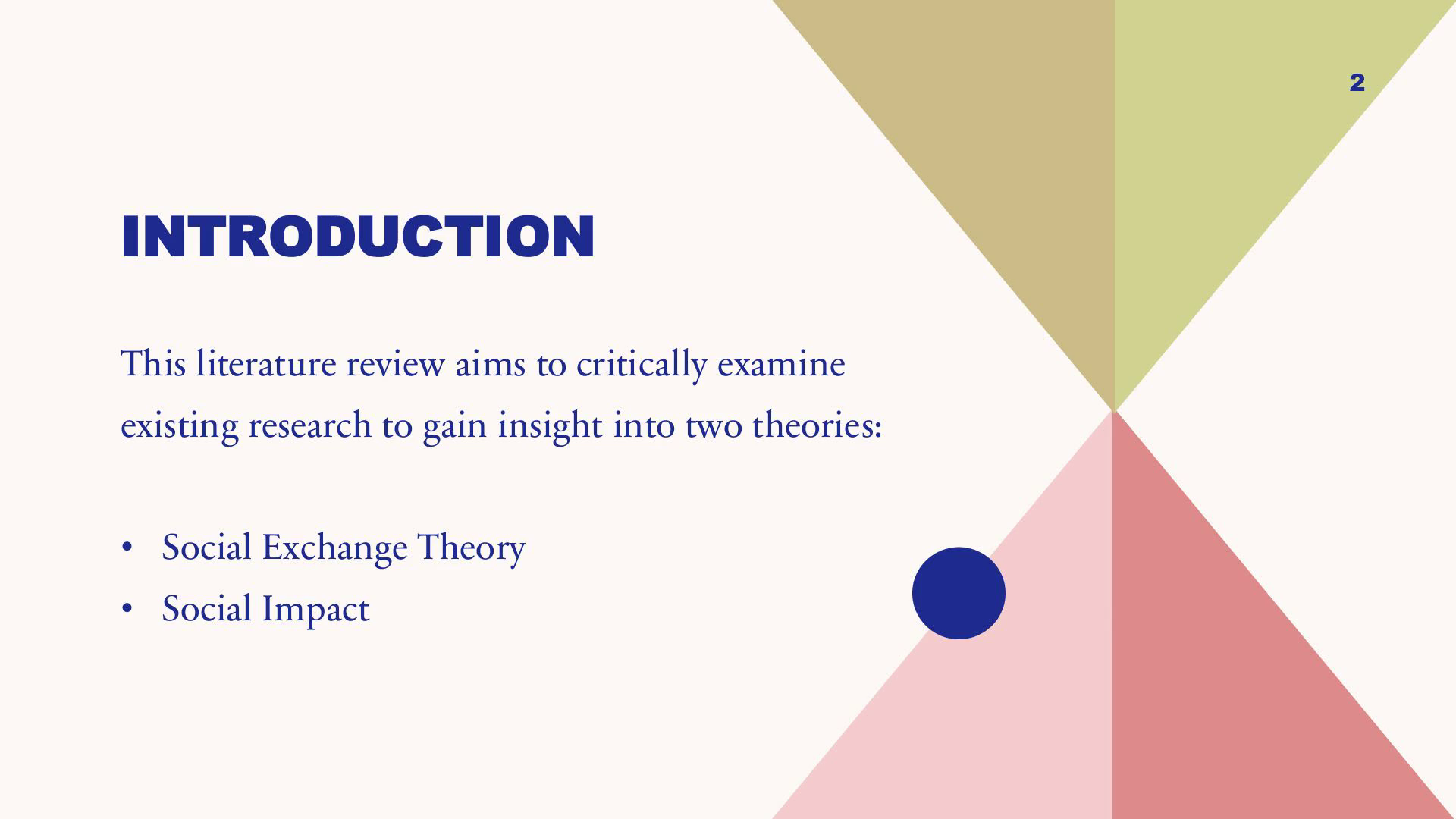
Literature Review Presentation
Scene 2 (0s)
[Audio] 2 INTRODUCTION This literature review aims to critically examine existing research to gain insight into two theories: Social Exchange Theory Social Impact.
Scene 3 (11s)
[Audio] SOCIAL EXCHANGE THEORY A PERCEPTION OF THE BENEFITS OF GIVING IS AN EFFECTIVE MOTIVATION IN THE FORMATION OF CONSUMERS' ATTITUDE TOWARD THE CHARITABLE CAUSE AND IN THEIR GIVING BEHAVIOR. INSPIRED BY THE STORIES OF PEOPLE WHO HAVE BEEN HELPED TRUST HAS A POSITIVE EFFECT ON GIVING BEHAVIOR THEY PERCEIVE IT TO BE A WIN-WIN SITUATION UNDERSTAND THE SOCIAL, EMOTIONAL AND FUNCTIONAL MOTIVES THAT ATTRACT DONORS TO ONE ORGANIZATION OVER ANOTHER.
Scene 4 (37s)
[Audio] SOCIAL IMPACT THEORY Explains how individuals are influenced by others and how they influence others in turn. Purpose and Intent- the need for long-term tangible goals. Outcome and Indicators- define outcomes that lead to the change we want to see. Track indicators over time options are qualitative, quantitative, survey, online engagement measures via google analytics..
Scene 5 (1m 1s)
[Audio] 5 SOCIAL MEDIA STRATEGIES AND SATISFACTION Social Media Strategies and Satisfaction Interactivity. When interactivity is available on social media, people can feel intensely involved with an organization and they can have an enjoyable experience using social media. Social media as an indispensable marketing tool to reach more consumers and increase support from the public potential donors learn more about the NPO's charitable cause through the two-way communication.
Scene 6 (1m 27s)
[Audio] 6 CONCLUSION Both Social Exchange Theory and Social Impact Theory provide interpersonal relationships and valuable insights for nonprofit internet marketing. Using social media platforms such as: - Facebook - X formerly known as Twitter - Instagram and other outlets will make a huge impact and create long term relationships..
Scene 7 (1m 49s)
[Audio] 7 REFERENCES HOW SOCIAL MEDIA STRATEGIES OF NONPROFIT ORGANIZATIONS AFFECT CONSUMER DONATION INTENTION AND WORD-OF-MOUTH Feng, Yi; Du, Lanying; Ling, Qian. Social Behavior and Personality; Palmerston North Vol. 45, Iss. 11, (2017): 1775-1786. DOI:10.2224/sbp.4412 Raman, A. (2016). How do social media, mobility, analytics and cloud computing impact nonprofit organizations? A pluralistic study of information and communication technologies in Indian context. Information Technology for Development, 22, 400-421. https://doi.org/b52b Lovejoy, K., Waters, R. D., & Saxton, G. D. (2012). Engaging stakeholders through Twitter: How nonprofit organizations are getting more out of 140 characters or less. Public Relations Review, 38, 313-318. https://doi.org/b5z7 Krebs, D. (1982). Altruism: A rational approach. In N. Eisenberg (Ed.), The development of prosocial behavior (pp. 5377). New York, NY: Academic Press. Shipps, B., & Phillips, B. (2013). Social networks, interactivity and satisfaction: Assessing sociotechnical behavioral factors as an extension to technology acceptance. Journal of Theoretical and Applied Electronic Commerce Research, 8, 35-52. https://doi.org/b5z9 https://www.youtube.com/watch?v=lm8nQeSPDpU https://journals.sagepub.com/doi/10.1177/08997640221123590?icid=int.sj- .citing-articles.8.
Scene 8 (1m 54s)
[Audio] THANK YOU Sakethia Mackey Resources Development and Marketing in Nonprofits.
Scene 1 (1m 56s)
NON-PROFIT MARKETING THEORIES AND INTERNET MARKETING LITERATURE REVIEW PRESENTATION.